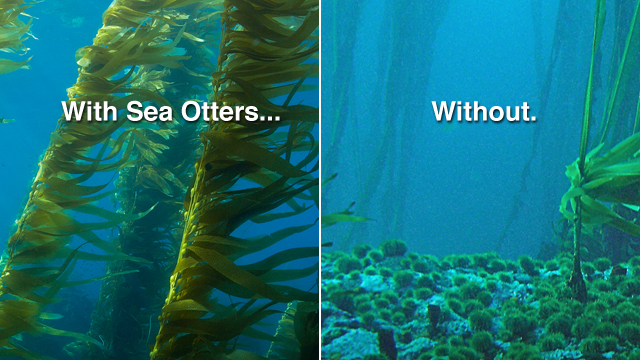By Eleanor Solomon, Oregon Wild Intern
Sea otters are adorable animals. With their thick fur and tiny round eyes, almost no one can resist their charm. But besides their cuteness, why are they important?
Sea otters are a keystone species. A keystone species is a species that is crucial to an ecosystem—without it other members of the ecosystem perish. Sea otters play a crucial role of maintaining the abundance of kelp in coastal ecosystems. Animals that sea otters eat, such as sea urchins, feed on kelp. Without sea otters, sea urchins can eat all the kelp, which provides habitat and food for thousands of other marine animals. Because of this, sea otters are essential to marine ecosystems.
The population of sea otters worldwide has been volatile. Before the arrival of Europeans to the Americas, there were an estimated 150,000-300,00 sea otters. But in the 18th and 19th century, sea otters were hunted for their fur almost to extinction, and their world population was reduced to 1,000-2,000. Because of this, in 1911, the International Fur Seal Treaty was passed, which prohibited hunting of fur-covered sea animals. Later, they were protected under the Endangered Species Act in 1977.
After the act and the treaty were passed, the population of sea otters recovered somewhat, and today there are an estimated 106,000. However, other dangers still plague sea otters. In 1989, an oil spill in Alaska killed hundreds, perhaps thousands, of sea otters. Sea otters are still classified as an endangered species, and in Oregon the situation is worse.
Though sightings have increased in recent years, Oregon does not have a single permanent sea otter resident. This seems odd, because the world population is relatively substantial. Almost all sea otters are found off the shores of Alaska and East Asia, with a fraction in California and Washington. Why is Oregon not on the list? California, Alaska, and Washington all made considerable efforts to replenish sea otter populations, and all had relative success, especially Alaska. Oregon, however, has not made much of an effort.
Much of Oregon’s coastal waters are polluted by oil and chemical spills and carbon emissions. Pathogens from sewage water runoff have also contaminated the water, and infect sea otters with deadly diseases. Among these are toxoplasmosis and sarcocystis, which are caused by kitty litter. Because of this, California has regulations about how to dispose of kitty litter because of its virulence. Clearly our coastal waters need to be improved in order to provide habitat for sea otters. In recent years, there have been increasing numbers of sea otter sightings off the Oregon coast. It's time for the state to take action.
Like I said before, sea otters are incredibly cute. But more than that, they are an important part of coastal ecosystems. I care about sea otters not only for their cuteness, but also because of their lives, and because of the marine wilderness they represent. In the last decade, endangered gray wolves have made a comeback in Oregon. I'd like to see a similar recovery for sea otters. When I'm 50, I hope to see richer, healther and more biologically diverse wilderness in our state. Sea otters are a part of that. The question is: will Oregonians make the effort to help sea otters and the coastal ecosystem that needs them?


